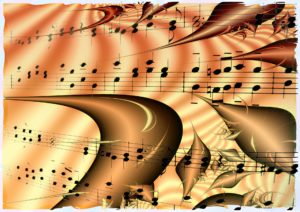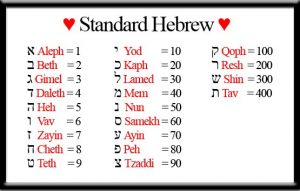The Hebrew culture has said from the very beginning that their “aleph-bet” is a set of living letters. Since these letters are considered living, they must have a vibrational frequency. But how do you find that frequency? Enquiring minds wanted to know. There’s a story to tell through these letters that connects many puzzle pieces, ultimately leading us into the very depths of creation.
 I have a fascination about all things frequency. The lure of the “frequency bug” kick-started this research project that spanned several years. Other than my dissertation, this is the longest I’ve worked on any one research project. Early on, I found it important to look for patterns first and foremost. This required delving a bit deeper into music history, theory, temperament, concert pitch, and tuning. Yes, I’ve had a lot of music history and theory but still, it required dusting off old materials to refresh my understanding on how music came to be as we know it today. Blog posts spawned from my research as I searched for the frequencies of the Hebrew alphabet (alep-bet). I’m thankful for the people who sent articles, videos, and links to websites.
I have a fascination about all things frequency. The lure of the “frequency bug” kick-started this research project that spanned several years. Other than my dissertation, this is the longest I’ve worked on any one research project. Early on, I found it important to look for patterns first and foremost. This required delving a bit deeper into music history, theory, temperament, concert pitch, and tuning. Yes, I’ve had a lot of music history and theory but still, it required dusting off old materials to refresh my understanding on how music came to be as we know it today. Blog posts spawned from my research as I searched for the frequencies of the Hebrew alphabet (alep-bet). I’m thankful for the people who sent articles, videos, and links to websites.
It soon became obvious that nature (including music) tends to fall into patterns; everything being interconnected. That goes hand-in-hand with understanding what contributed to performance practices throughout musical history. So much about why and how people created music involves understanding temperament, concert pitch, tuning, etc.. I gathered a lot of information from scholars on other subjects, too. I’m thankful to all of them for their unknown assistance.
The other major piece of the puzzle involved my own musicianship. As a classical musician, there’s a level of expectations in rehearsals. This is more than simply having the music prepared. Tuning in a rehearsal is a tricky business. Tuning involves understanding harmonics, chord progressions, intervals, music theory, how instruments respond to the weather, etc. in addition to a finite ability to hear very small differences in pitch and timbre. It shocked me how much that knowledge and experience played a major role, especially towards the end of this project.
 In the beginning, I experimented with every form of Hebrew gematria, thinking that something was missing when nothing made sense. I knew to move on when a pattern or natural law couldn’t be found. When I found patterns, it was often by accident. Well, more likely – by divine inspiration. For some time, I expected there to be an absolute – one confirmed method that clearly made musical sense. It was time to throw expectations out the window. I missed the simple and obvious puzzle pieces that stared me right in the face, especially in the beginning. I believe this is why research projects take time. We need to learn a bunch of stuff before we see the obvious. Then we wonder “Huh!? How did I miss that?”
In the beginning, I experimented with every form of Hebrew gematria, thinking that something was missing when nothing made sense. I knew to move on when a pattern or natural law couldn’t be found. When I found patterns, it was often by accident. Well, more likely – by divine inspiration. For some time, I expected there to be an absolute – one confirmed method that clearly made musical sense. It was time to throw expectations out the window. I missed the simple and obvious puzzle pieces that stared me right in the face, especially in the beginning. I believe this is why research projects take time. We need to learn a bunch of stuff before we see the obvious. Then we wonder “Huh!? How did I miss that?”
I’ve probably seen most every study out there. However, the moment I say that, another one pops up. I’m always happy to read results from various projects and take great interest in what other musicians are coming up with concerning the Hebrew alphabet and music. That being said, send me anything that might be relevant.
Moving along… Many people who’ve gone before me in looking for the frequencies of the Hebrew letters have approached it from a different angle. They are all unique and very intriguing. However, I knew that in order to find what I needed, I had to dig much deeper. The many rabbit trails took me to some interesting places. Some were helpful for this project and others will remain on a shelf for future projects.
My discovery:
- The frequencies of the Hebrew letters utilize a combination of the standard, small number, and mispar gadol (large number) gematria.
- These frequencies are based off the musical harmonic (overtone) series.
- They are nearly an identical match to the the A=432 concert pitch. (It’s impossible to have a perfect match because of tuning.)
- Intervals (the distance between notes) play a major role.
- Important numbers within the Hebrew culture are present in the patterns.
- The frequencies aren’t “absolute” as there are certain choices for pitches, much like key signatures dictate what notes to play in each scale.
- The results line up with historical performance practices of the day and Hebrew culture.
In the beginning, I assumed I’d find one letter per pitch. That didn’t work because everything I came up with sounded horrible and didn’t fit within the natural laws of resonance, harmonics, and music theory. It required a trip through the Torah to gather evidence. When the High Priest sung the names of God in the Holy of Holies and David sung the Psalms, neither of them were looking at sheet music and singing the same way every time. (Oops, sheet music wasn’t invented yet.) There had to be another way that still followed natural laws but also allowed for creativity, musical inspiration, and individuality.
Part of free will is to have the ability to create as we feel inspired. Yes, there are natural laws that govern how things work. However, there is still freedom within certain laws. We weren’t created to be robots. Now, bringing that thought process over to this, we see the law of harmonics and how it perfectly lines up with the Hebrew aleph-bet. The creative part is deciding what order to place the notes.
Interested in Creating This Music Yourself?
 My musical curiosity got the best of me when someone said one day, “You should see if you can find the musical frequencies of the Hebrew letters.” Challenge accepted! My close friends encouraged me to keep going when it felt like I was constantly hitting brick walls. Now that I’m finally done, I’ve created an audio teaching with instructions and demonstrations. There’s lots of information crammed into three PDF files that are all downloadable. The audio teaching includes a musical example using the letters for the name of Yahweh (YHVH) to create a song.
My musical curiosity got the best of me when someone said one day, “You should see if you can find the musical frequencies of the Hebrew letters.” Challenge accepted! My close friends encouraged me to keep going when it felt like I was constantly hitting brick walls. Now that I’m finally done, I’ve created an audio teaching with instructions and demonstrations. There’s lots of information crammed into three PDF files that are all downloadable. The audio teaching includes a musical example using the letters for the name of Yahweh (YHVH) to create a song.
The accompanying PDF is full of pictures and charts to assist any musician through his/her own creation process. Even non-musicians can learn about the historical and scientific aspects of how this research came together. It’s a walk down “music history lane” and performance practices in order to understand how the patterns in music, nature, and math interconnect. This ultimately leads the reader on a journey of discovery into how the Hebrew letters are represented by musical frequencies.
The PDF includes the following:
- Comparison of the Hebrew gematria to the A=432 concert pitch, musical patterns, and the musical harmonic/overtone series.
- An explanation of the harmonic series, musical intervals, concert pitch, temperament, and enharmonics. This information is necessary as part of the process to create music using this system.
- A full frequency chart needed for creating Hebrew letter (and word) music.
The downloadable teaching set includes the following:
- Audio teaching with examples and practical information.
- PDF with Hebrew letter frequency chart that also includes many pictures and charts to help the reader understand what to do and how to do it.
- PDF chart of the A=432 concert pitch (15 octaves) in Pythagorean tuning.
- BONUS: PDF chart of the A=444 concert pitch (15) octaves in Pythagorean tuning. (Although the Hebrew letters aren’t based off the A=444 concert pitch, many people still like to use this tuning. This chart should assist with that effort.)
CLICK HERE to purchase the materials. You’ll be re-routed through the product page to Gumroad to make a secure purchase.
Would you like me to create a Hebrew word song just for you?
I know a lot of people aren’t musicians but really like to listen to music! With that in mind, I can create a personal song based on a Hebrew word or short phrase of your choosing! A personal song is only $75 and I create it just for you! Personal songs also make great gifts. I just need to know who it’s for.
In addition, I have a “Song of the Month” that I put out at the beginning of each Hebrew month. Each month has a Hebrew letter associated with it that I’ll use to create that month’s unique song. I also have a voice-over activation for people to do throughout the month that goes with it. That subscription is $10 per month. CLICK HERE to sign up.
As usual, if you have any questions or comments, feel free to leave those below! If you have something to share, feel free to add the link in the comments below.
Shalom!
Del
[mailerlite_form form_id=2]


[…] where I provide audio and written instructions on how to create music using the Hebrew letters. CLICK HERE for that article. The details for the technical bits are there. Here, we take a look at the […]
This is BRILLIANT, Del!!!!! I’ve been trying to figure out how to engage the Hebrew letters in frequency (song) first using an interpretation of the Hebrew text cantillation marks, then Susanne Haik-Vantoura’s interpretation. But the music just didn’t sound right, even though my piano is tuned to A432. I was stuck.
When I read your blog, I immediately downloaded and studied your teaching materials. In just a couple hours I had drafted a set of frequencies to engage the letters of two particular Hebrew words I wanted to know better.
CAUTION: Don’t do this right before bed: This “work” is so energizing you might not be able to sleep, lol! (It’s 2:40 a.m. as I write this :-D)
Thank you! You’ve opened wide a door to creatively engage the living letters of the Hebrew Aleph-beit. This is truly awesome material!
Kathy, thanks for this feedback! Please keep us posted on how your songs turn out. I’m so excited that you’re finding these frequencies energizing!